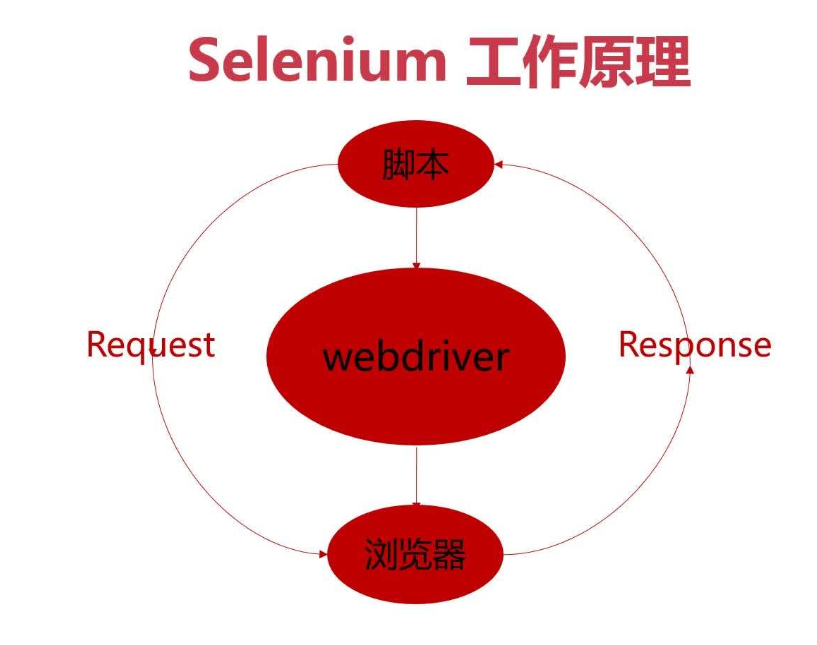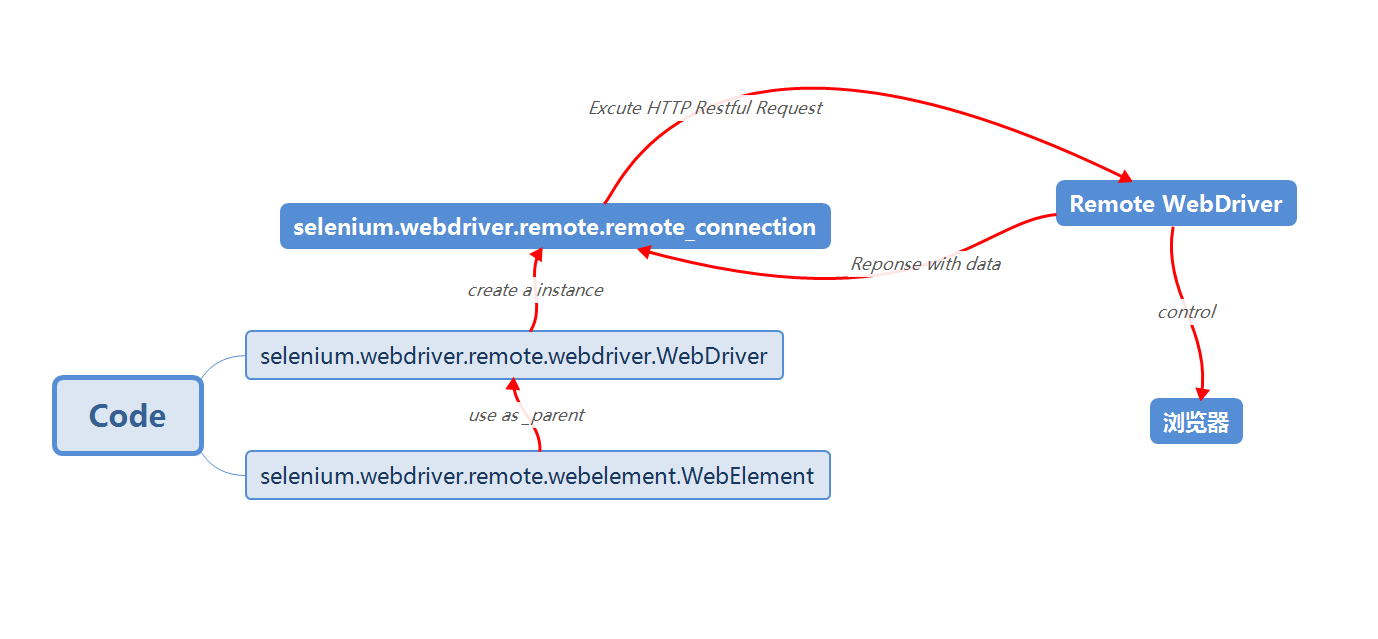selenium的历史
- selenium1.x:这个时候的selenium,使用的是JavaScript注入技术与浏览器打交道,需要Selenium RC启动一个Server,将操作Web元素的API调用转化为一段段Javascript,在Selenium内核启动浏览器之后注入这段Javascript。Javascript可以获取并调用DOM的任何元素,自如的进行操作。由此才实现了Selenium的目的:自动化Web操作。这种Javascript注入技术的缺点是速度不理想,而且稳定性大大依赖于Selenium内核对API翻译成的Javascript质量高低。
- selenium2.x:相比于selenium1.x,2.x版本整合了webdriver以及原版selenium,两个项目合二为一,虽然名字还叫selenium,但也可以叫Webdriver。这个版本的selenium是利用浏览器原生的API,封装成一套更加面向对象的Selenium WebDriver API,直接操作浏览器页面里的元素,甚至操作浏览器本身(截屏,窗口大小,启动,关闭,安装插件,配置证书之类的)。由于使用的是浏览器原生的API,速度大大提高,而且调用的稳定性交给了浏览器厂商本身,显然是更加科学。然而带来的一些副作用就是,不同的浏览器厂商,对Web元素的操作和呈现多少会有一些差异,这就直接导致了Selenium WebDriver要分浏览器厂商不同,而提供不同的实现。
发展史请看下图:

以下进入正题
结构
要通过selenium实现自动化测试,最最主要是需要三种东西。
- 测试需要用的代码
- webdriver
- 浏览器
今天想要分享的也是这三者关系。
代码
selenium支持多种语言(java/c#/python/ruby)。测试工程师通过编程语言,调用浏览器对应API实现需要的功能。
webdriver
webdriver,就像是一个媒介,代码驱动webdriver。上文提过,不同浏览器有不同的webdriver,例如火狐的FirefoxDriver,谷歌的 ChromeDriver.
浏览器
不同的浏览器对应不同的webdriver。

从上图,测试代码输入操作给webdriver,webdriver再去控制浏览器,最终达到的效果就是代码实现对浏览器的操作。
以查找元素为例,查看代码与webdriver的交互
以下python为例
from selenium import webdriver
driver = webdriver.Chrome()
这里driver是webdriver.Chrome()的对象,我们查看webdriver.Chrome()的源码,发现本质是
from .chrome.webdriver import WebDriver as Chrome 从目录名可知这来自chrome的webdriver,再次对这个WebDriver溯源,发现它是继承了一个RemoteWebDriver类,注释的含义是:控制ChromeDriver并允许驱动浏览器。
class WebDriver(RemoteWebDriver):
"""
Controls the ChromeDriver and allows you to drive the browser.
You will need to download the ChromeDriver executable from
http://chromedriver.storage.googleapis.com/index.html
"""
def __init__(...)
...
再次对继承的RemoteWebDriver类溯源,发现其是selenium.webdriver.remote.webdriver.WebDriver
class WebDriver(object):
"""
Controls a browser by sending commands to a remote server.
This server is expected to be running the WebDriver wire protocol
as defined at
https://github.com/SeleniumHQ/selenium/wiki/JsonWireProtocol
:Attributes:
- session_id - String ID of the browser session started and controlled by this WebDriver.
- capabilities - Dictionaty of effective capabilities of this browser session as returned
by the remote server. See https://github.com/SeleniumHQ/selenium/wiki/DesiredCapabilities
- command_executor - remote_connection.RemoteConnection object used to execute commands.
- error_handler - errorhandler.ErrorHandler object used to handle errors.
"""
_web_element_cls = WebElement
def __init__(self, command_executor='http://127.0.0.1:4444/wd/hub',
desired_capabilities=None, browser_profile=None, proxy=None,
keep_alive=False, file_detector=None, options=None):
...
注释的含义是:通过向远程服务器发送命令来控制浏览器。 该服务器应该运行WebDriver有线协议。这里先停一下,等会我们会再回来继续了解这个类。
以python为例,我们在在selenium库中,通过ID获取界面元素的方法是这样的:
ele = driver.find_element_by_id('id')
以上同方法,对代码溯源,find_elements_by_id是selenium.webdriver.remote.webdriver.WebDriver类的实例方法。在代码中,我们直接使用的其实不是selenium.webdriver.remote.webdriver.WebDriver这个类,而是针对各个浏览器的webdriver类,例如webdriver.Chrome()。所以说在测试代码中执行各种浏览器操作的方法其实都是selenium.webdriver.remote.webdriver.WebDriver类的实例方法。接下来我们再深入selenium.webdriver.remote.webdriver.WebDriver类来看看具体是如何实现例如**find_element_by_id()**的实例方法的。
def find_element(self, by=By.ID, value=None):
"""
Find an element given a By strategy and locator. Prefer the find_element_by_* methods when
possible.
:Usage:
element = driver.find_element(By.ID, 'foo')
:rtype: WebElement
"""
if self.w3c:
if by == By.ID:
by = By.CSS_SELECTOR
value = '[id="%s"]' % value
elif by == By.TAG_NAME:
by = By.CSS_SELECTOR
elif by == By.CLASS_NAME:
by = By.CSS_SELECTOR
value = ".%s" % value
elif by == By.NAME:
by = By.CSS_SELECTOR
value = '[name="%s"]' % value
return self.execute(Command.FIND_ELEMENT, {
'using': by,
'value': value})['value']
这个find_element方法最后调用了一个excute方法,我们再来看看这个excute方法:
def execute(self, driver_command, params=None):
"""
Sends a command to be executed by a command.CommandExecutor.
发送一个命令由command.CommandExecutor执行。
:Args:
- driver_command: The name of the command to execute as a string.
- params: A dictionary of named parameters to send with the command.
:Returns:
The command's JSON response loaded into a dictionary object.
"""
if self.session_id is not None:
if not params:
params = {'sessionId': self.session_id}
elif 'sessionId' not in params:
params['sessionId'] = self.session_id
params = self._wrap_value(params)
response = self.command_executor.execute(driver_command, params)
if response:
self.error_handler.check_response(response)
response['value'] = self._unwrap_value(
response.get('value', None))
return response
# If the server doesn't send a response, assume the command was
# a success
return {'success': 0, 'value': None, 'sessionId': self.session_id}
正如注释中提到的一样,其中的关键在于
response = self.command_executor.execute(driver_command, params)
一个名为command_executor的对象执行了execute方法。
名为command_executor的对象是RemoteConnection类的对象,并且这个对象是在新建selenium.webdriver.remote.webdriver.WebDriver类对象的时候就完成赋值的self.command_executor = RemoteConnection(command_executor, keep_alive=keep_alive)。
结合selenium.webdriver.remote.webdriver.WebDriver类的类注释来看:WebDriver类的功能是通过给一个remote server发送指令来控制浏览器。而这个remote server是一个运行WebDriver wire protocol的server。而RemoteConnection类就是负责与Remote WebDriver server的连接的类。
可以注意到有这么一个新建WebDriver类的对象时候的参数command_executor,默认值='http://127.0.0.1:4444/wd/hub'。这个值表示的是访问remote server的URL。因此这个值作为了RemoteConnection类的构造方法的参数,因为要连接remote server,URL是必须的。
现在再来看RemoteConnection类的实例方法execute。
def execute(self, command, params):
"""
Send a command to the remote server.
Any path subtitutions required for the URL mapped to the command should be
included in the command parameters.
:Args:
- command - A string specifying the command to execute.
- params - A dictionary of named parameters to send with the command as
its JSON payload.
"""
command_info = self._commands[command]
assert command_info is not None, 'Unrecognised command %s' % command
data = utils.dump_json(params)
path = string.Template(command_info[1]).substitute(params)
url = '%s%s' % (self._url, path)
return self._request(command_info[0], url, body=data)
这个方法有两个参数
- command
- params
command表示期望执行的指令的名字。打开self._commands这个dict,查看Command.FIND_ELEMENT的value.
指令的URL部分包含了几个组成部分:
- HTTP请求方法。WebDriver wire protocol中定义的指令是符合RESTful规范的,通过不同请求方法对应不同的指令操作。
- sessionId. sessionId表示了remote server和浏览器的一个会话,指令通过这个会话变成对于浏览器的一个操作。
- element 这一部分用来表示具体的指令。
而selenium.webdriver.remote.command.Command类里的常量指令又在各个具体的类似find_elements的实例方法中作为execute方法的参数来使用,这样就实现了selenium.webdriver.remote.webdriver.WebDriver类中实现各种操作的实例方法与WebDriver wire protocol中定义的指令的一一对应。
而selenium.webdriver.remote.webelement.WebElement中各种在WebElement上的操作也是用类似的原理实现的。
实例方法execute的另一个参数params则是用来保存指令的参数的,这个参数将转化为JSON格式,作为HTTP请求的body发送到remote server。
remote server在执行完对浏览器的操作后得到的数据将作为HTTP Response的body返回给测试代码,测试代码经过解析处理后得到想要的数据。
总结

初学者文中难免可能有疏漏之处,希望各位大佬指正
补充
为了怕同志们理解错,把雨泽大佬上课说的selenium工作原理写在下面,本菜鸟是在此基础上从另一角度出发来看:
- Service: service->subprocess调用命令行打开webdriver.exe
- Client: urlib3->访问服务(接口)

欢迎来到testingpai.com!
注册 关于